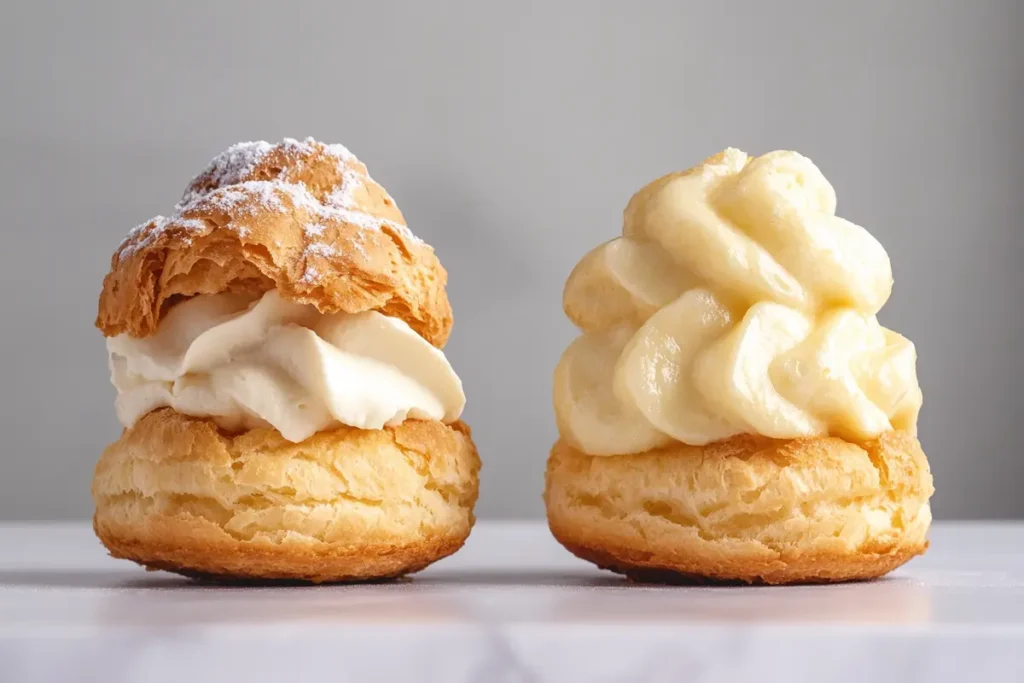Introduction to Cream Puffs
What Are Cream Puffs?
Are cream puffs high in sugar? This common question often arises when enjoying these beloved desserts. Cream puffs, made from a unique dough called choux pastry, are a classic treat filled with whipped cream, custard, or even ice cream. Unlike other doughs, choux is cooked before baking, resulting in a light, airy texture that pairs perfectly with its creamy fillings.
The pastries’ golden-brown shells are slightly crispy, while the luscious fillings create a melt-in-your-mouth experience. Often topped with powdered sugar or chocolate drizzle, their sweetness makes them an irresistible favorite—but it also sparks curiosity about their sugar content.
Popularity and Cultural Significance
Originating in France, cream puffs have transcended borders to become a global symbol of indulgence. Whether showcased in high-end bakeries or cherished at family gatherings, their simplicity and rich flavor have earned them a place in the hearts of dessert lovers everywhere.
Beyond their popularity, cream puffs hold a cultural presence in culinary competitions and pastry art. But behind the allure of this elegant dessert lies an important nutritional query: Are cream puffs high in sugar, and how does this impact our health?
Nutritional Profile of Cream Puffs
Nutritional Content of Cream Puffs (Per 100g)
| Nutrient | Per 100g |
|---|---|
| Calories | 360 kcal |
| Carbohydrates | 20 g |
| Sugar | 8 g |
| Fats | 25 g |
| Protein | 3 g |
| Sodium | 180 mg |
| Fiber | 1 g |
Caloric Content
One of the first things people wonder about cream puffs is their calorie count. After all, these tasty treats pack a lot of flavor into a small package. On average:
- A medium-sized cream puff (approximately 130g) contains around 468 calories.
- Mini cream puffs, which are much smaller (about 13g), clock in at only 35 calories per piece.
These figures may vary slightly depending on the recipe or additional toppings, but it’s clear that portion size makes a big difference. So, if you’re concerned about calorie intake, smaller cream puffs can be a smarter choice.
Macronutrient Breakdown
Understanding the macronutrients in cream puffs can help you grasp their nutritional impact. Here’s a typical breakdown:
- Carbohydrates: These pastries often contain between 15 to 20 grams of carbs per serving, primarily from the dough and sugary fillings.
- Fats: Cream puffs are relatively high in fat, thanks to ingredients like butter and cream. A single medium-sized puff can contain about 33.67 grams of fat.
- Proteins: While not a significant source of protein, cream puffs offer around 2 to 4 grams per serving, mostly from eggs used in the dough.
This combination of carbs and fats contributes to their rich, satisfying texture—but it also makes them calorie-dense.
Sugar Content in Cream Puffs
Now to the big question: Are cream puffs high in sugar?
The sugar content in cream puffs depends largely on the filling and toppings. A typical cream puff contains between 5 to 10 grams of sugar per serving, mostly from the sweetened cream and optional powdered sugar dusting.
Interestingly, the choux pastry itself contains little to no sugar, relying on butter and eggs for its flavor and structure. This means that by tweaking the filling, you can significantly reduce the sugar content without compromising the dessert’s integrity.
Comparison with Other Desserts
Compared to many other desserts, cream puffs fall somewhere in the middle when it comes to sugar content. For example:
- A slice of chocolate cake contains around 30 grams of sugar per serving.
- A single chocolate chip cookie has about 14 grams of sugar.
So, while cream puffs aren’t exactly low-sugar, they’re not as sugar-heavy as some of their dessert counterparts. However, they still require moderation, especially if you’re watching your sugar intake.
Hidden Sugars in Store-Bought Cream Puffs

Store-bought cream puffs can be sneaky when it comes to sugar. Manufacturers often use additional sweeteners to extend shelf life or enhance flavor. Checking the nutritional label is crucial to avoid consuming more sugar than you intended.
For homemade cream puffs, you have full control over the amount of sugar, making them a better option for those who want to indulge without overdoing it. Try this mini cream puffs recipe to create your own at home.
This comprehensive look at the nutritional profile of cream puffs highlights both their indulgent nature and their potential to fit into a balanced diet. Still, there’s more to explore about their health impact and tips for enjoying them responsibly. Stay tuned for Part 3, where we dive into the health implications of eating cream puffs!
Health Implications of Consuming Cream Puffs
Impact on Blood Sugar Levels
For anyone concerned about managing blood sugar, cream puffs can be a tricky indulgence. Their carbohydrate and sugar content can lead to a rapid spike in blood sugar levels, particularly when consumed in large quantities. This is especially true for those with diabetes or insulin resistance, as the body may struggle to process the sugars efficiently.
However,The glycemic impact of cream puffs can vary depending on the filling and the amount of sugar used. Learn more about other sweet treats and their sugar levels, like are protein puddings high in sugar. For example, opting for sugar-free or low-sugar cream fillings can make a noticeable difference.
Role in Weight Management
While cream puffs are undeniably delicious, their high-calorie count and fat content make them a dessert to enjoy in moderation. Overindulging in these pastries, especially as part of a diet rich in other calorie-dense foods, can lead to weight gain over time.
That said, no single food is inherently “fattening”—it’s all about balance. If you love cream puffs, consider offsetting them with healthier meals during the day, or enjoy them as an occasional treat rather than a regular indulgence.
Sugar and Energy Levels
The sugar in cream puffs provides a quick burst of energy, which can be beneficial for short-term needs, like a pick-me-up during a busy day. However, this energy surge is often followed by a sugar crash, leaving you feeling sluggish. Consuming cream puffs alongside protein or fiber-rich foods can help slow the release of sugar into the bloodstream, reducing this effect.
Nutritional Benefits of Cream Puffs
Surprisingly, cream puffs do offer some minor nutritional perks. For instance:
- Calcium: Ingredients like cream and butter contribute small amounts of calcium, supporting bone health.
- Iron: Eggs and flour provide traces of iron, essential for oxygen transport in the blood.
Although these benefits are minimal, they’re worth noting for those who enjoy cream puffs as part of an otherwise balanced diet.
Allergies and Dietary Restrictions
Cream puffs may not be suitable for everyone. Key allergens like eggs, dairy, and gluten are standard ingredients, which could pose a challenge for individuals with food sensitivities or intolerances. Luckily, creative recipes exist for those seeking dairy-free, gluten-free, or vegan alternatives.
Psychological Comfort in Moderation
Let’s not forget the role of desserts like cream puffs in emotional well-being. Treating yourself occasionally can bring joy and satisfaction, contributing to a positive relationship with food. The key lies in mindful indulgence, savoring each bite without guilt or overindulgence.
As we’ve seen, the health implications of cream puffs depend largely on how they’re consumed. With awareness and moderation, you can enjoy these delightful pastries without derailing your health goals. Up next, we’ll explore ways to enjoy cream puffs responsibly and discuss healthier alternatives!
Moderation and Healthier Alternatives
Enjoying Cream Puffs in Moderation
If you’re a fan of cream puffs, the good news is that you don’t have to give them up entirely to maintain a balanced diet. Moderation is the secret ingredient to enjoying these pastries guilt-free. Here are a few tips to help you indulge responsibly:
- Portion Control: Opt for mini cream puffs instead of larger ones. They’re just as satisfying but contain fewer calories and less sugar per serving.
- Occasional Treat: Save cream puffs for special occasions or as a once-in-a-while dessert, rather than a regular indulgence.
- Pair with Healthier Foods: Balance the sweetness by pairing cream puffs with nutrient-dense foods, like fresh fruit or a cup of unsweetened tea.
By being mindful of portions and timing, you can savor cream puffs without disrupting your overall nutritional goals.
Healthier Cream Puff Recipes

If you enjoy baking, experimenting with healthier recipes can be a game-changer. With a few simple tweaks, you can make cream puffs that are lighter and less sugary but still delicious. For inspiration, check out this protein cookie recipe for another low-sugar dessert idea.
- Reduce Sugar: Swap refined sugar in the filling for natural sweeteners like honey or stevia. You can also reduce the sugar by half without significantly altering the taste.
- Use Whole-Grain Flour: Incorporating whole-grain flour into the choux pastry adds fiber, which helps slow the digestion of carbohydrates.
- Low-Fat Cream Alternatives: Instead of heavy cream, use Greek yogurt or light whipped toppings to cut down on fat.
Alternative Fillings
Traditional cream puffs are filled with whipped cream or custard, but there are plenty of creative and healthier alternatives to try:
- Fruit Compotes: Fill your cream puffs with naturally sweetened fruit compotes like strawberry or blueberry.
- Yogurt-Based Fillings: A dollop of flavored Greek yogurt can provide creaminess with added protein.
- Unsweetened Coconut Cream: Whipped coconut cream is a dairy-free option that’s lower in sugar and just as indulgent.
Low-Sugar Store-Bought Options
For those who don’t have time to bake, some brands offer low-sugar or sugar-free cream puffs. While these may still contain artificial sweeteners, they’re a better choice for people monitoring their sugar intake. Always check the nutritional label to ensure the product aligns with your dietary needs.
The Role of Exercise
Enjoying desserts like cream puffs doesn’t have to derail your health goals when combined with regular physical activity. Exercise not only burns calories but also helps regulate blood sugar levels, making it easier to enjoy occasional treats without worry.
Cream puffs don’t have to be an all-or-nothing choice. With a few adjustments, you can enjoy their rich, creamy flavors while still prioritizing your health. Up next, we’ll tackle some frequently asked questions about cream puffs and their nutritional impact!
Frequently Asked Questions About Cream Puffs and Their Sugar Content
Are cream puffs high in sugar?
Cream puffs contain moderate amounts of sugar, typically ranging from 5 to 10 grams per serving, depending on the size and filling. While not excessively sugary, their sugar content can add up if consumed in large quantities or paired with additional toppings.
How many calories are in a cream puff?
The calorie content varies depending on the size: a medium-sized cream puff (around 130g) contains approximately 468 calories, while a mini cream puff (about 13g) has only 35 calories. Always consider portion size to manage caloric intake effectively.
Can I include cream puffs in a diabetic diet?
Individuals with diabetes should approach cream puffs cautiously. Their sugar and carbohydrate content can cause blood sugar spikes. Opting for sugar-free or low-sugar recipes and enjoying them in small portions can make them more diabetes-friendly.
What are some healthier alternatives to traditional cream puffs?
Healthier options include using whole-grain flour, reducing sugar, and replacing heavy cream with lighter fillings such as Greek yogurt, fruit compotes, or whipped coconut cream. These modifications retain the deliciousness while cutting down on excess calories and sugar.
How can I reduce the sugar content in homemade cream puffs?
To reduce sugar in homemade cream puffs, consider using natural sweeteners like stevia or honey in the filling. You can also skip or limit the powdered sugar dusting on top and experiment with sugar-free versions of your favorite fillings.
Are store-bought cream puffs less healthy than homemade ones?
Generally, store-bought cream puffs tend to have higher sugar and preservative content than homemade ones. When making them yourself, you control the ingredients, making it easier to reduce sugar and fats for a healthier treat.
Conclusion
Cream puffs are a delightful dessert enjoyed by people around the globe. While they contain moderate sugar levels and are calorie-dense, they can still fit into a balanced diet when consumed in moderation. By being mindful of portion sizes, experimenting with healthier recipes, and balancing their indulgence with an active lifestyle, you can enjoy the rich, creamy flavors of cream puffs without guilt.
Whether you’re crafting homemade cream puffs with alternative fillings or savoring a store-bought version, the key lies in mindfulness. As with any dessert, cream puffs are best enjoyed as an occasional treat that complements, rather than dominates, your overall diet. So, go ahead—treat yourself, and savor every bite responsibly!

